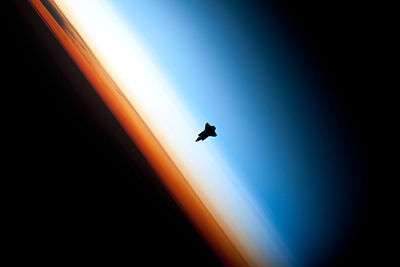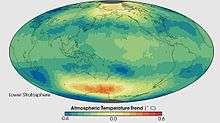Stratosphere



The stratosphere (/ˈstrætəˌsfɪər, -toʊ-/[3][4]) is the second major layer of Earth's atmosphere, just above the troposphere, and below the mesosphere. About 20% of the atmosphere's mass is contained in the stratosphere. The stratosphere is stratified in temperature, with warmer layers higher and cooler layers closer to the Earth. The increase of temperature with altitude, is a result of the absorption of the Sun's ultraviolet radiation by ozone. This is in contrast to the troposphere, near the Earth's surface, where temperatures decreases with altitude. The border between the troposphere and stratosphere, the tropopause, marks where this temperature inversion begins. Near the equator, the stratosphere starts at 18 km (59,000 ft; 11 mi); at mid latitudes, it starts at 10–13 km (33,000–43,000 ft; 6.2–8.1 mi) and ends at 50 km (160,000 ft; 31 mi); at the poles, it starts at about 8 km (26,000 ft; 5.0 mi). Temperatures vary within the stratosphere with the seasons, in particular with the polar night (winter). The greatest variation of temperature takes place over the poles in the lower stratosphere; those variations are largely steady at lower latitudes and higher altitudes.
Ozone and temperature
The mechanism describing the formation of the ozone layer was described by British mathematician Sydney Chapman in 1930. Molecular oxygen absorbs high energy sunlight in the UV-C region, at wavelengths shorter than about 240 nm. The oxygen atoms produced combine with molecular oxygen to form ozone. Ozone in turn is photolysed much more rapidly than molecular oxygen as it has a stronger absorption that occurs at longer wavelengths, where the solar emission is more intense. Ozone (O3) photolysis produces O and O2. The oxygen atom product combines with atmospheric molecular oxygen to reform O3, releasing heat. The rapid photolysis and reformation of ozone heats the stratosphere resulting in a temperature inversion. This increase of temperature with altitude is characteristic of the stratosphere; it's resistance to vertical mixing means that it is stratified. Within the stratosphere temperatures increase with altitude (see temperature inversion); the top of the stratosphere has a temperature of about 270 K (−3°C or 26.6°F).[5] This vertical stratification, with warmer layers above and cooler layers below, makes the stratosphere dynamically stable: there is no regular convection and associated turbulence in this part of the atmosphere. However, exceptionally energetic convection processes, such as volcanic eruption columns and overshooting tops in severe supercell thunderstorms, may carry convection into the stratosphere on a very local and temporary basis. Overall the attenuation of solar UV at wavelengths that damage DNA by the ozone layer allows life to exist on the surface of the planet outside of the ocean. All air entering the stratosphere must pass through the tropopause, the temperature minimum that divides the troposphere and stratosphere. The rising air is literally freeze dried; the stratosphere is a very dry place. The top of the stratosphere is called the stratopause, above which the temperature decreases with height.
Sydney Chapman gave a correct description of the source of stratospheric ozone and its ability to generate heat within the stratosphere; he also wrote that ozone may be destroyed by reacting with atomic oxygen, making two molecules of molecular oxygen. We now know that there are additional ozone loss mechanisms, and that these mechanisms are catalytic meaning that a small amount of the catalyst can destroy a great number of ozone molecules. The first is due to the reaction of hydroxyl radicals OH· with ozone. OH is formed by the reaction of electronically excited oxygen atoms produced by ozone photolysis, with water vapor. While the stratosphere is dry, additional water vapor is produced in situ by the photochemical oxidation of Methane (CH4). The HO2 radical produced by the reaction of OH with O3 is recycled to OH by reaction with oxygen atoms or ozone. Laughing gas or Nitrous oxide (N2O) is produced by biological activity at the surface and is oxidised to NO in the stratosphere; the so-called NOx radical cycles also deplete stratospheric ozone. Finally, Chlorofluorocarbon molecules are photolysed in the stratosphere releasing chlorine atoms that react with ozone giving ClO and O2. The chlorine atoms are recycled when ClO reacts with O in the upper stratosphere, or when ClO reacts with itself in the chemistry of the Antarctic ozone hole. Paul J. Crutzen, Mario J. Molina and F. Sherwood Rowland were awarded the Nobel Prize in Chemistry in 1995 for their work describing the formation and decomposition of stratospheric ozone.
Aircraft flight
Commercial airliners typically cruise at altitudes of 9–12 km (30,000–39,000 ft) which is in the lower reaches of the stratosphere in temperate latitudes.[6] This optimizes fuel efficiency, mostly due to the low temperatures encountered near the tropopause and low air density, reducing parasitic drag on the airframe. Stated another way, it allows the airliner to fly faster for the same amount of drag. It also allows them to stay above the turbulent weather of the troposphere.
The Concorde aircraft cruised at mach 2 at about 18,000 m (59,000 ft), and the SR-71 cruised at mach 3 at 26,000 m (85,000 ft), all within the stratosphere.
Because the temperature in the tropopause and lower stratosphere is largely constant with increasing altitude, very little convection and its resultant turbulence occurs there. Most turbulence at this altitude is caused by variations in the jet stream and other local wind shears, although areas of significant convective activity (thunderstorms) in the troposphere below may produce turbulence as a result of convective overshoot.
On October 24, 2014, Alan Eustace became the record holder for reaching the altitude record for a manned balloon at 135,890 ft (41,419 m). Mr Eustace also broke the world records for vertical speed reached with a peak velocity of 1,321 km/h (822 mph) and total freefall distance of 123,414 ft (37,617 m) - lasting four minutes and 27 seconds.[7]
Circulation and mixing
The stratosphere is a region of intense interactions among radiative, dynamical, and chemical processes, in which the horizontal mixing of gaseous components proceeds much more rapidly than does vertical mixing.
An interesting feature of stratospheric circulation is the quasi-biennial oscillation (QBO) in the tropical latitudes, which is driven by gravity waves that are convectively generated in the troposphere. The QBO induces a secondary circulation that is important for the global stratospheric transport of tracers, such as ozone[8] or water vapor.
During northern hemispheric winters, sudden stratospheric warmings, caused by the absorption of Rossby waves in the stratosphere, can be observed in approximately half of winters when easterly winds develop in the stratosphere. These events often precede unusual winter weather [9] and may even be responsible for the cold European winters of the 1960s.[10]
Stratospheric warming of the polar vortex results in its weakening. When the vortex is strong, it keeps the cold, high pressure air masses "contained" in the arctic; when the vortex weakens, air masses move equatorward, and results in rapid changes of weather in the mid latitudes.
Life
Bacteria
Bacterial life survives in the stratosphere, making it a part of the biosphere.[11] In 2001 an Indian experiment, involving a high-altitude balloon, was carried out at a height of 41 kilometres and a sample of dust was collected with bacterial material inside.[12]
Birds
Some bird species have been reported to fly at the lower levels of the stratosphere. On November 29, 1973, a Rüppell's vulture was ingested into a jet engine 11,278 m (37,000 ft) above the Ivory Coast, and bar-headed geese reportedly overfly Mount Everest's summit, which is 8,848 m (29,029 ft).[13][14][15]
Discovery
Léon Teisserenc de Bort from France and Richard Assmann from Germany, in separate publications and following years of observations, announced the discovery of an isothermal layer at around 11–14 km, which is the base of the lower stratosphere. This was based on temperature profiles from unmanned instrumented balloons.[16]
See also
- Le Grand Saut
- Lockheed U-2
- Paris Gun (first artificial object to reach stratosphere)
- Red Bull Stratos
- RQ-4 Global Hawk
- Service ceiling
References
- ↑ "ISS022-E-062672 caption". NASA. Retrieved 21 September 2012.
- ↑ "Atmospheric Temperature Trends, 1979-2005". NASA/Earth Observatory. 6 July 2007. Retrieved 24 August 2015.
- ↑ Jones, Daniel (2003) [1917], Peter Roach, James Hartmann and Jane Setter, eds., English Pronouncing Dictionary, Cambridge: Cambridge University Press, ISBN 3-12-539683-2
- ↑ "Stratosphere". Merriam-Webster Dictionary.
- ↑ Seinfeld, J. H., and S. N.(2006), Atmospheric Chemistry and Physics: From Air Pollution to Climate Change 2nd ed, Wiley, New Jersey
- ↑ "Altitude of a Commercial Jet". Hypertextbook.com. Retrieved 2011-11-08.
- ↑ "Google's Alan Eustace beats Baumgartner's skydiving record". BBC News.
- ↑ N.Butchart, A.A. Scaife, J. Austin, S.H.E. Hare, J.R. Knight. Quasi-biennial oscillation in ozone in a coupled chemistry-climate model, Journal of Geophysical Research.
- ↑ M.P. Baldwin and T.J. Dunkerton. 'Stratospheric Harbingers of Anomalous Weather Regimes, Science Magazine.
- ↑ A.A. Scaife, J.R. Knight, G.K. Vallis, C.K. Folland. A stratospheric influence on the winter NAO and North Atlantic surface climate, Geophysical Research Letters.
- ↑ S. Shivaji et al, "Isolation of three novel bacterial strains, Janibacter hoylei sp. nov., Bacillus isronensis sp. nov. and Bacillus aryabhattai sp. nov. from cryotubes used for collecting air from upper atmosphere.", Int J Syst Evol Microbiol, 2009.
- ↑ M. M. Woolfson. Time, Space, Stars & Man: The Story of the Big Bang. World Scientific; 2013. ISBN 978-1-84816-933-3. p. 388.
- ↑ Laybourne, Roxie C. (December 1974). "Collision between a Vulture and an Aircraft at an Altitude of 37,000 Feet" (PDF). The Wilson Bulletin. Wilson Ornithological Society. 86 (4): 461–462. ISSN 0043-5643. JSTOR 4160546. OCLC 46381512.
- ↑ "Audubon: Birds". Audubonmagazine.org. Retrieved 2011-11-08.
- ↑ Thomas Alerstam, David A. Christie, Astrid Ulfstrand. Bird Migration (1990). Page 276.
- ↑ http://empslocal.ex.ac.uk/people/staff/gv219/classics.d/Hoinka-tropo97.pdf
External links
-
 The dictionary definition of stratosphere at Wiktionary
The dictionary definition of stratosphere at Wiktionary